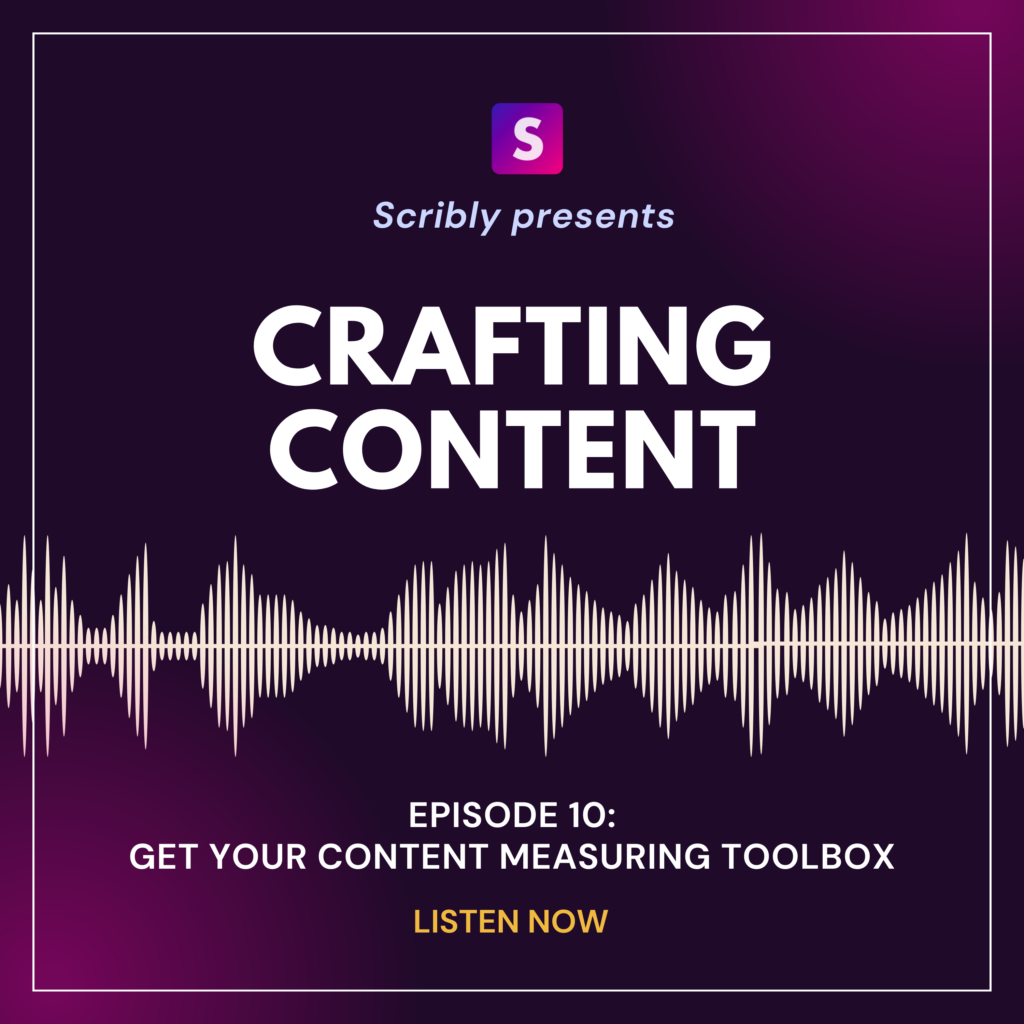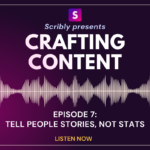Crafting Content, Episode 10 – A content marketing podcast from Scribly
Crafting Content Episode 10: Get your content measuring toolbox
The tenth episode of Scribly’s “Crafting Content” podcast and the final feature of our ‘content marketing mistakes’ mini-series is here!
Today’s topic is about the importance of measuring and analyzing the performance of your content marketing efforts. We discuss why tracking and auditing performance is so important, how often you should be doing it, what tools you should use to collect the data, and what KPIs to measure success against.

You can listen to the full episode here: Scribly’s Content Marketing Podcast Episode 10: Get your content measuring toolbox
Episode 10: Get your content measuring toolbox [transcript]
Elle: The idea of this mistake came about from a conversation we were having about our biggest pet peeves when it comes to content marketing. Mine is the perception that some customers have about content marketing. When we talk to leads or we do cold outreach, a response that we commonly get is “Oh, we don’t believe in content marketing” or “We don’t believe SEO is real”. The point is, there’s this idea that when we’re doing content marketing, we’re creative brains who need to sit in a quiet, dark room and just come up with ideas that we think might be interesting to the reader. We then make a list of blogs for that month and that’s the extent of it. But actually there’s a scientific and data-driven approach that happens within content marketing.
There is so much data that goes into it, not only from the marketing side of things (like knowing who your audience is, what channels they’re on, the right way of talking to them,etc) but also having the data to look back on their content marketing strategy so far (what’s been successful, what’s been unsuccessful, etc). Once we have that data, we then figure out content pillars and content clusters before going into the nitty gritty of the content. So, I wanted to talk about failing to analyze and this perception that data doesn’t come into content marketing — because it absolutely 100% does.
Taylor: Which is not to say we don’t also sit in cold, dark rooms but that comes later.
This is definitely an area that I am less well versed in or do not have formal training in. Where does someone who doesn’t know or didn’t think they had to use data in content marketing even begin?
Elle: That’s a great question. The first place is just to read online advice. Typically, when you’re talking about content marketing data, you just want to start with an audit of what’s already there. So, the first step is just going to be collecting data and knowing where to find it.
It could be as simple as creating a really long list of all the types of content that you have: your blog, social, website, et cetera. If you wanted to focus on your website and blog, you would pull a list of all the URLs that are live on your site. Then, you need to learn how to use tools like Google Analytics and Google Search Console, as well as keyword tools like AHrefs and SEMrush. There are training courses on all of those available online. There’s an education that needs to happen before you can dive into it.
But a lot of data is — once you’re able to read it —- relatively self-explanatory. So, to give you an example, if you want to know if your home page is achieving what you want it to achieve from, let’s say an SEO perspective, you might run that URL through a keyword tool and that will tell you if it’s ranking, if it’s ranking for relevant keywords, if it’s ranking highly, if it’s ranking for low search volume keywords, if it ranks for branded keywords, etc. You can see, gather, and download all this information. Then, you just look at what that data tells you.
You can then use a tool like Google Analytics to see if a page is actually driving organic traffic, how much, how frequently, where the traffic is coming from, etc. With Search Console, you’d be able to see how many clicks a page gets, what keywords are driving traffic to site, et cetera.
Once you’ve pulled all that data and you know how to pull that data, the analysis side of things is just logic. If you’re not driving organic traffic and you’re not ranking for keywords, the conclusion is this page isn’t optimized. We probably need to make some changes.
It sounds really simple. but it’s a process that loads of people skip when they’re creating content. Because, the importance of having this kind of analytical, data-driven process is very much understanding where your strengths and more importantly, where your weaknesses are.
And then once you know how to evaluate your own strengths and weaknesses, you’re also able to analyze your competitors’, so you can understand where they’re beating you, where they’re strongest. You can figure out where they’re not visible and try and dominate in that space. This analysis allows you to understand what you’re doing right, what you’re doing wrong, where your improvements need to be, and more importantly, where your focus is going to have the biggest impact.
When it comes to content marketing, you might not have the biggest budget for this channel because it takes time, it takes investment, but you want to get — and I hate this expression — the biggest bang for your buck. So, you’re going to need that data to understand what’s going to have the biggest impact with the smallest amount of effort. And you’re not going to know that if you haven’t got the data analysis to back it.
Alex: If I’m a client and I come to Scribly with my website and I say no one’s finding my website, no one’s clicking on the new blogs I’m posting, no one’s going to the landing pages, no one’s buying my stuff, and I don’t know why. I don’t know why no one’s finding it, what would you do? Or what would we do to figure out why this website isn’t receiving any traffic? What’s the step-by-step process? What tools would we use? And what would each tool tell us specifically?
Elle: We would do an audit of their website, which means that we analyze their strengths and weaknesses, deep dive into where they’re visible, what performs well, where they struggle, etc.
To get really technical — if you’re interested in the nitty gritty — we would run the website through a crawling software (we use Screaming Frog) to pull every single URL that exists on that website (if you are just clicking through to a website, you can’t necessarily find all pages). We then cross-reference those URLs with the rest of the data.
So, then I would run the website through a keyword tool, like ahrefs or Semrush. Then, we can essentially map out which pages rank for what keywords, which pages don’t rank at all, which pages rank for low search volume keywords, which pages don’t rank high enough for keywords. And then if they’ve given us access to their Google Analytics, we’ll pull all of the data from the last twelve months and look at how many views each page had, how many users have clicked on it, what the bounce rate was, what the average time spent on page was, et cetera. And then, really boringly, we just pull it into a huge excel document.
And then honestly, line by line, you just go through and make notes of what you’re seeing. We might note, for example, that the homepage ranks number one for their branded keyword — and obviously that’s really important. It’s probably the highest-traffic driver on their website.
We might then see that they’ve got ten category pages. One page shows all of the women’s dresses that they sell, another all of the women’s shoes, another men’s sports shorts, or whatever the category that they’ve chosen to go with is.
You can then refer to your data to see that the women’s dresses page ranks for a really low search volume and really niche keyword, like “women’s New Year’s Eve, sparkly dresses” that’s got a search volume of ten. It’s also restricted to the new year. So, we’re talking about a very limited, non-evergreen term. Realistically, we want that page to rank for “women’s occasion dresses”, “women’s going out dresses” etc. We’re thus able to not only see what keywords each page is ranking for, but evaluate the value of those keywords.
So, if the keyword a page ranks for has a really low search volume, even if that page ranked top for that keyword, realistically, it’s driving one maybe two people to the brand’s website. But if the brand were able to optimize that page for more relevant, higher search volume keywords, then the value of that page is going to increase. So again, we’re able to make that data-driven assessment of you’re targeting the wrong keywords.
As a result of that, we can see that a brand isn’t getting the organic traffic that it expect. But we can say that if we were to optimize these pages for these keywords, this is the kind of improvement that they can expect based on where they rank for that keyword. We can say what optimizations need to happen to improve a page, and we can do that on a page-by-page basis.
It’s a very formulaic, analytical, and relatively easy for customers to understand process that allows us to make the best recommendations. And then again, brands can prioritize actions based on this data.
So, if your homepage isn’t driving any traffic, that’s a problem. That’s like the number one place people should be going. If your homepage is only ranking branded keywords (meaning a keyword that has your brand name in it) then that means that the only people who are able to find your website are people who already know that your brand exists, so you’re not reaching new customers. If we only ranked for the term Scribly, for example, only people actively searching for Scribly would find our website. But because we rank for the term “content marketing agency”, people looking for a content marketing agency who don’t necessarily know about Scribly or haven’t heard of Scribly yet can still find our website, and that grows your brand awareness. So again, it’s all about that evaluation of the value of what that site is ranking for, and then being able to make the recommendation based on what the data is telling you.
Sorry, that was a really long-winded question. I’ve not really answered it totally, which tells you quite how meaty that kind of topic is. But that’s certainly the initial first step of that process.
Alex: And is that process a one-and-done thing? S,o we do that and then give the client the data and then that’s it. Or is there value to doing this on a regular basis and analyzing how your site is performing rather than just initially?
Elle: Initially, the analysis is about identifying the opportunity and the long-term vision for what we’re trying to achieve. But then, as you say, it’s about checking in and monitoring the progress to see whether what you’re doing is working.
So, if you’ve recommended — if we go back to the example of the dresses page — optimizing that page towards women’s occasion dresses and then we do that optimization work, you would typically expect to see some movement within three months, maybe a little bit longer. But we’d need to be able to track that progress.
So, you want to be regularly analyzing and running the data on that page to what new keywords you are ranking for and if your position in SERPs are increasing. And in the same way, you’d be able to go to Google Analytics and see that this page is now starting to drive traffic.
So there’s value in that, in terms of reassuring yourself and the client that your strategy is working and being able to prove the value of their investment. It is worth their time because the changes have driven customers to the site. So, there are benefits to doing this analysis in terms of tracking progress, but also just to understand your customer better and monitor where their interests lie.
So I know we’ve talked a lot about category pages, but, what we see really often from a blog content perspective is a website will have like one blog that does really well and no one really understands why it drives like 98% of the traffic to their blog. Often it does really well in the website as a whole and the rest of their blog just isn’t really having the same impact. So you might make recommendations that, because this topic does well, let’s build out other content off the back of that. So, more in-depth pieces or a wider cluster piece.
You wouldn’t know that that should be a focus area if you didn’t have the data. And then by checking in regularly you’re able to see, oh yeah, okay, this is the right strategy. Or if those add-ons aren’t driving traffic either, then that probably tells you, right, we just need to reevaluate the whole blog strategy. But again, you wouldn’t know unless you were checking in regularly.
Taylor: So if you go and make those changes, say you make more content on that topic, that does really well for you. What’s the time frame that you expect to start seeing the effect of those changes? Because I think that’s something that people ask us a lot.
Elle: And it’s a fair question. Right. you’re spending a lot of money with a company and some writers and you’re wondering where the results are. Often people working in paid and PPC, where you spend a dollar, you get $2 back and it’s kind of a guarantee.
SEO and content marketing more widely are much more of a long-term game. We usually say three to six months, but it really does depend on the health of your wider website. If only the home page ranks for a few branded keywords and the rest of the website doesn’t perform, it’s going to take a while for all of the other pages to start ranking following our changes. We’re looking more at the six-month mark because we’re essentially starting from zero. Whereas if we were looking at a website where the homepage ranks highly for branded and non-branded keywords, and some of their pages rank just off page one, then it’s going to be so much easier to go from page two onto page one than it is to go to page ten or nothing to those higher up pages. So, it’s an accumulative effect. So in that situation, you might look at the three-month mark.
Taylor: I guess maybe we should clarify too that when we’re talking about page one, page two, we’re talking about the the Google search results pages. So, if you have to click through six extra o’s in Google, you’re probably not getting seen by very many people.
Alex: Is that still how it works on Google?
Taylor: Isn’t it?
Alex: I don’t click the O’s. Or is it now just numbered?
Taylor: I think they have both.
Alex: Okay.
Elle: I think they have both. Yeah.
Taylor: I always like to click the O’s though, because it’s fun.
Elle: Yeah, sorry, habit of the trade of not explaining that correctly. Thank you, Taylor.
Alex: So, saying that this is like a long-term thing that you should be doing, how often do you think it’s worth doing a full content audit of a website? Is it something you should be doing monthly? quarterly? What’s the sweet spot, do you think?
Elle: I’d say monthly is overkill because of how long it takes to see movement. I think if you’re starting a new project, it’s good to just start from scratch. So, do a full website audit. And then each quarter, I would just review where your efforts have been focused so you don’t necessarily need to go back on the entire website. It might be, look, we’ve published these new blog posts or we’ve optimized these new pages and you can look more specifically at the impact of your actual actions. And then as a yearly review, look at the bigger picture of what changes helped improve your website.
Let’s go back to our earlier example. We’re a content marketing agency. We’re trying to rank our homepage for the keyword “content marketing agency”. So, we’re publishing a lot of blog posts that offer a guide to content marketing. Ones which are channel-specific, content like “Should you use an agency or a freelancer” etc. All that kind of content that is going to showcase us as an authority within the content marketing space to hopefully help us rank higher for that wider keyword. So, on a quarterly basis, you might assess if these individual blog posts are ranking. Then, on a yearly or six-month basis, you might assess if you’ve reached your wider objective of helping the homepage rank higher.
I’d say monthly is definitely overkill. We do it on a quarterly basis so that Google has time to do its thing: crawl, optimize, and rank your content.
Taylor: Maybe we should leave it there for now, since this topic has so much to cover. And let us know if in future episodes you want to know more about specific topics that we touched on today. We might end up doing some individual episodes about audits or content marketing data tools or search engine rankings for beginners, or something like that. So if any of those ideas sound interesting to you, let us know. You can always get in touch with us, through our website, scribblymedia.com, and we will be back soon with another episode. Thanks for listening.
Thank you for listening to Crafting Content, a content marketing podcast from Scribly. You can find more information about what we cover today in our show notes. Scribly is a content marketing agency that helps you boost traffic, generate sales, and increase your bottom line. With our end-to-end service, we take care of everything from content audits and strategy to content creation and management across websites, blogs, socials, and email. We’re a small but mighty team of experienced strategists and marketers who specialize in content creation. If you want to learn more about how Scribly can help your business, please get in touch. You can find more information and send us a message on our website, scriblymedia.com. We’d love to hear from you.




